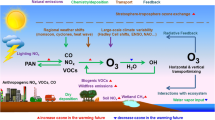Abstract:
The goal of this study is to assess complications in atmospheric stable boundary layers which are not included in numerical models of the stably stratified boundary layer and to provide a formulation of surface fluxes for use in numerical models. Based on an extensive interpretive literature survey and new eddy correlation data for the stable boundary layer, this study defines two prototype stable boundary layers: the weakly stable case and the very stable case. The weakly stable boundary layer is amenable to existing models. The very stable boundary layer eludes modeling attempts due to breakdown of existing formulations of turbulence and due to features found in the atmosphere which are not normally included in models. The latter includes clear-air radiative cooling, low-level jets, surface heterogeneity, gravity waves, meandering motions, and other mesoscale motions which propagate from outside the local domain. While these mechanisms are not essential to understanding idealized or laboratory versions of the stable boundary layer, they complicate comparisons of numerical models and theories with actual atmospheric boundary layers. Statistics which describe various features of the stable boundary layer are offered for future comparison with modeling results.
Similar content being viewed by others
Author information
Authors and Affiliations
Additional information
Received 13 June 1997 and accepted 19 November 1997
Rights and permissions
About this article
Cite this article
Mahrt, L. Stratified Atmospheric Boundary Layers and Breakdown of Models . Theoret. Comput. Fluid Dynamics 11, 263–279 (1998). https://doi.org/10.1007/s001620050093
Issue Date:
DOI: https://doi.org/10.1007/s001620050093




